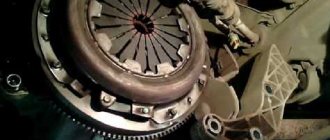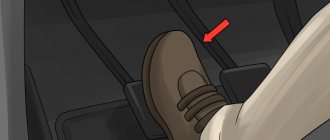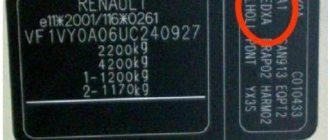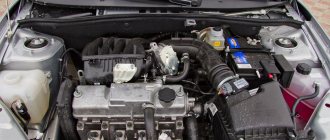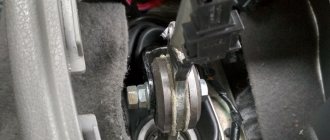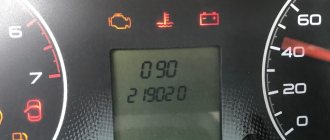Engine Features
Due to the design of the car's cooling system, the engine does not warm up above 80 degrees. The management of AvtoVAZ does not see anything wrong with this; they have an official information letter on this matter. You can read it in the material: What is the operating temperature of an 8 valve engine.
The engine design is as simple as an axe. There are no hydraulic compensators, no sores were noticed. Mostly problems can arise due to malfunctions in the engine management system.
Video of acceleration to 100 km per hour
I haven’t shot my video yet, it’s winter, so we’ll wait for the weather to warm up. That's when I'll post it on our YouTube channel. In the meantime, here's a video from Grantovodov.
Here's another interesting video. It is interesting because the measurement is made using an application with a navigator, which means that the speedometer readings are more accurate if the navigator is well calibrated. Everyone knows that the higher the speed, the more the car’s speedometer lies.
Engine life
Under the hood in the “Norma” configuration
The question that causes the most controversy. Officials talk about a mileage of 150,000 km before major repairs; some have traveled 200 thousand km or more without problems. I have a friend who already had his engine repaired at 40 thousand km because the timing belt broke. Yes, the engine here is “plug-in” - this means that if the timing belt breaks, the pistons meet the valves and you can see the fist of friendship.
Engine resource 87 hp. 21116 according to the passport - 150,000 km!
Studying the forums, based on my own experience, I can say that it all depends on how you will operate the engine. The most banal thing: the quality of the oil (choose correctly) and engine operating modes - this is what the mileage before you need to do major repairs depends on.
Removing and installing the engine
We dismantle the engine if it is necessary to overhaul or replace it. We carry out the work on an inspection ditch or overpass. Relieve the pressure in the power system (see “Replacing the fuel filter”). Disconnect the wire terminal from the negative terminal of the battery. We drain the engine oil (see “Replacing the engine oil and oil filter”) and coolant (see “Replacing the coolant”). Disconnect the additional muffler pipe from the catalytic collector (see “Removing the additional muffler”). Disconnect the tip of the fuel supply hose from the fuel rail tube (see “Removing the fuel rail and injectors”). We remove the air filter (see “Removing the air filter and air intake”) and the air supply hose to the throttle assembly (see “Removing the air supply hose to the throttle assembly”). Disconnect the vacuum brake booster hose and the tip of the canister purge solenoid valve tube from the receiver fittings (see “Removing the receiver”). Disconnect the engine management system wiring harness connector from the coolant temperature sensor connector (see “Removing the coolant temperature sensor”). We disconnect the cooling system hoses from the cover and thermostat housing, and also disconnect the tip of the “mass” wire from the cylinder head stud (see “Removing and checking the thermostat”).
Using the “8” head, we loosen the tightening of the clamps securing the three hoses of the cooling system to the pipes of the pump supply pipe... ...and remove the hoses from the pipe pipes. We remove the generator (see “Removing the generator”).
Using a 13mm socket, unscrew the three bolts securing the generator bracket...
...and remove the bracket (there are mounting sleeves in two holes). We disconnect the engine management system wiring harness connectors from: the fuel injector wiring harness connectors and oxygen concentration sensors; connectors: throttle control unit, ignition coil, crankshaft position sensor, knock sensor, low oil pressure warning sensor, canister purge valve, vehicle speed sensor (see the corresponding chapters: “Engine”, “Power system”, “Engine management system” "). We move the wiring harnesses away from the engine to the side. We remove the gearbox (see “Removing and installing the gearbox”) and the clutch (see “Replacing the “basket” and driven disk of the clutch”). Place soft material on the lower part of the windshield (you can use fabric folded several times). Raise the hood to a vertical position so that its rear edge rests on the fabric under the windshield. We fasten the chains of the lifting device to the engine on the right side with a standard eye, and on the left side with a bolt screwed into the hole in the cylinder block intended for fastening the clutch housing. Having tightened the chains, we remove the stop from under the engine that supported the engine when removing the gearbox. Holding the engine, unscrew the three bolts securing the bracket for the right support of the power unit to the cylinder block...
...with a 13" head - the upper fastening bolt...
...and with a “15” head – two bolts of the lower bracket fastening (one bolt is not visible in the photo). Before removing the engine, it is necessary to check that all hoses, tubes and wires are disconnected from the engine and laid aside. Raise the engine using a lifting device...
...and take it out of the engine compartment. We install the engine on the car in reverse order.
Repair of power unit components
As practice shows, nothing lasts forever, and neither do the components of VAZ power units. In this part of the article, we will consider the main malfunctions, as well as methods of elimination and repair.
Timing belt or how not to bend valves
Probably the most interesting question for most motorists is whether the valves on VAZ engines bend? As for the VAZ 11189 engine, we can say with confidence that the valves bend when the timing belt breaks. Of course, valves can bend for other reasons, but the most common is considered to be a broken timing belt.
Another question that car enthusiasts ask in car repair shops and on forums regarding the timing belt is how to prevent valve bending? Everything is very simple - change the timing belt and rollers according to the technical recommendations of the manufacturer. Thus, in the maintenance manuals for engine 11189, the recommended belt replacement period is 45-50 thousand kilometers.
What happens if the valve bends? Everything is very simple - after the valve mechanism is bent, such important elements as the valve guide, valve seat, and oil seals fail. Subsequently, it may happen that this problem affects the piston mechanism. In a word, if the valve bends, then you should hope for the best and expect the worst - that is, a major repair.
How to replace the timing belt and rollers:
- First, you need to remove the protective casing.
- Then, we fix the camshaft, but before that it is necessary to set the timing marks.
- Unscrew the tension roller to release the belt.
- Next, we dismantle the belt itself.
- We change the tension roller.
- Reinstall the timing belt.
The procedure for changing the timing belt, at first glance, seems to be quite simple, but not everything is so simple, and not every car enthusiast will be able to carry it out. Therefore, in order not to subsequently bend the valves, it is recommended to contact specialists at a car service center to carry out the procedure.
Water pump malfunction
The water pump circulates coolant through the engine system. This is done for cooling and to prevent the motor from burning out. The failure of such a unit means that further operation of the power unit is impossible, since overheating will occur and the first thing that will be affected is the cylinder head. To avoid this, you should regularly diagnose the part and replace it on time.
There is nothing difficult about replacing the pump. The procedure is similar to changing the timing belt. After removing the belt, unscrew the bolts securing the water pump and replace it. It should be noted that the coolant must be drained from the system and, after replacement, topped up to the required level.
ECU diagnostics
One of the most common procedures that motorists carry out is diagnosing faults in the electronic engine control unit. This procedure is often performed in a car service center, since not every driver has a special portable diagnostic PC.
Alternative engines
VAZ-21904
https://youtube.com/watch?v=VCdFeUSnOAY
https://youtube.com/watch?v=VCdFeUSnOAY
VAZ-21904 is a gasoline-powered sixteen-valve turbo engine with a displacement of 1.4 and a power of 163 hp. In addition, it is equipped with a lithium-ion battery and an electric motor. The basis for it was the VAZ-11194 engine; it was installed on Lada Kalina cars in the first generation. As for the VAZ-21904 itself, it is installed on Grant hybrids - VAZ-21904 sedans. The Volzhsky Automobile Plant tested four such vehicles equipped with three different hybrid engine options.
Fifth gear was replaced by the shaft of a robotic gearbox; it rotates thanks to a small electric motor with a power of 11 kW. This option turned out to be simpler and cheaper than using the standard scheme with the electric motor located between the gearbox and the internal combustion engine. Thus, there are four gears left, but this aspect will not create any problems for the car owner - the maximum speed (160 km/h) is achieved by the car in fourth gear.
Also, the terms of reference required the developers to fulfill two mandatory conditions - charging a hybrid car from electrical networks used in everyday life and the ability to move it in two modes at once - combined and electric. AvtoVAZ’s partners in the development of electronics were the Russian research institute NAMI and the Ricardo company from the UK. It was NAMI that developed the battery and electric motor for a hybrid car.
The car is capable of starting to move purely on electric power, with the internal combustion engine switched off. During the process of gaining speed, the gear shift will be carried out by a “robot”, and the precise output of the electric motor is responsible for synchronizing the rotation of the gears at this moment. When you start the gasoline engine, the car will begin to work in hybrid mode - with the same gear shifting, in which the electric motor will either help rotate the input shaft of the box, or will switch to generator mode, charging the battery.
According to tests, a hybrid car will consume 21% less fuel than a Granta with a conventional 1.6 engine. (measurements, of course, were carried out in a gentle mode, but the result obtained is very good).
Of course, only a few hope that the hybrid Lada Granta will be in great demand and will be able to generate any significant interest in the car market in the near future. At the moment, such vehicles are nothing more than a kind of aggregate carriers intended for testing various components separately. If we talk specifically about the hybrid type transmission, its serial production will begin in at least two to three years, and it will be installed on quite expensive Lada cars, most likely C-class. Thus, it is quite possible over time and we should expect an increase in demand for hybrid cars, but the main condition for this is a fundamental change in the attitude towards “ecological” transport not only of motorists, but also of the state, as well as the vehicle manufacturers themselves.
Design of 8-valve engines
The 11186 engine and its predecessor 11183 do not differ in the location of the components, although their displacement is different. And for motor 21116 (details about the service life and characteristics of motor 21116 here) a separate drawing is provided here. All components related to the lubrication system will be marked on the drawings.
A special feature of the design is the operating temperature of the engine, which in winter does not rise above 80 degrees. The manufacturer (AvtoVAZ) does not consider this feature to be a malfunction. The official information letter is in the material: operating temperature of an 8-valve engine.
The numbers in the figures indicate the details:
- Oil filler neck and plug – 7 (Fig. 1), 4 (Fig. 3);
- Drain plug – 17 (Fig. 2), 10 (Fig. 4);
- Oil filter – 14 (Fig. 2), 8 (Fig. 4);
- Diagnostic probe – 5 (Fig. 1), 9 (Fig. 3);
Photos 1 and 2 correspond to motor 11183 (11186), photos 3 and 4 are a drawing of motor 21116.
Engine name
What cars was it used in?
The manufacturer AvtoVAZ used engine 11183 to equip several car models:
- Lada Kalina – station wagon, sedan, hatchback;
- Lada Kalina II – second generation in similar bodies;
- Lada Granta – sedan, hatchback;
- 21101 – four-door sedan;
- 21112 – five-door station wagon;
- 21121 – short five-door hatchback;
- 2113 (since 2011) – three-door hatchback;
- 2114 (2006 – 2013) – five-door hatchback;
- 2115 Lada Samara-2 (2007 – 2012) – compact sedan.
Improved engine characteristics ensured the demand for cars of a similar configuration.
Step-by-step instruction
We offer you fairly simple instructions on how to independently replace the technical fluid in the engine of this car.
- First, you will need to purchase a new filter and oil in the amount corresponding to the modification of the power unit of your car.
- The easiest way to perform this procedure is in a garage pit or on an overpass. With some skill, you can change the oil even on a flat surface. You will only need to use an appropriate flat container to drain the old technical fluid.
- We drive the car into a pit or overpass, and then open the oil filler cap located on the engine under the hood. This will relieve excess pressure.
- Only after this do we install an empty container under the engine crankcase and unscrew the drain plug. To do this, you will need a 17 key. Remember that the oil may be hot, so proceed with extreme caution.
- You need to wait until the old oil has completely drained from the engine crankcase. This usually takes about 10 minutes, after which the drain plug must be screwed back in. Many car owners lose sight of this point, which leads to the fact that the new, fresh oil that has just been poured into the engine begins to leak out of the engine.
- At the next stage of work, it is necessary to replace the filter. It is located behind the engine. The easiest way to remove it is with a special puller. If you have the dexterity, you can use your hands on a cold engine. Just remember that there is also a small amount of oil inside the filter, so it is best to place a small container and act carefully. If the filter threads are rusty and stuck, you can pierce the filter with a screwdriver and use it as a lever. This will allow you to replace the filter as quickly as possible. It is recommended to pour 10-20 grams of fresh oil into it, then screw it into place.
- When pouring fresh auto lubricant into the engine through the neck, do not forget to monitor its level through the oil dipstick. The technical fluid level should be located between the minimum and maximum marks.
- After this, you will need to tighten the filler cap and start the engine for a few minutes. After this, we turn off the engine and check it for leaks.
- The next day, do not forget to check the level with a dipstick on a cold engine. If necessary, you will need to add technical fluid to the engine.
At this point, all service work is completely completed. As you can see, changing the oil in a Lada Granta engine does not present any difficulty. You don't need to use any special tools.
All service work will take the car owner at most half an hour, while you can save money on carrying out such service at specialized service stations.
Advantages and disadvantages
VAZ 21116 is an easy-to-maintain and at the same time reliable engine. Once every 15,000 kilometers it is necessary to change the engine oil. The timing belt should be inspected every 25,000 kilometers, and replaced after 200,000 km.
The advantages include the low cost of the cylinder head and reduced noise level. And major repairs can be carried out by a car owner who has experience in disassembling and assembling engines. This is possible because the engine components are interchangeable. Easy dismantling of mounted elements makes it unnecessary to disassemble the engine part of the vehicle.
Similar article Technical characteristics of 1JZ GE engine
The advantages of the VAZ engine include:
- ease of repair;
- good traction at low speeds;
- there is no need to tighten the timing belt, since the tensioner is in effect. If you try to tension the belt and tighten it yourself, the roller bearings and water pump will fail;
- The timing drive is protected by a plastic impact-resistant casing;
- economical fuel consumption;
- reliability and durability.
However, there are also disadvantages to this unit. Experienced car owners note:
- the need to regulate valve clearances, since there are no hydraulic compensators;
- frequent malfunctions during operation of even a new VAZ engine;
- low environmental friendliness, which does not meet European standards and does not reach modern Euro 4;
- purchase of expensive foreign components.
The unit often has problems with some sensors at idle. This is a childhood disease that was abandoned by engineers from the moment the engine was released. Therefore, it cannot be corrected and you have to accept it.
Device location and rules of use
The fuel filter of a Lada Granta car, according to standard indicators, is designed for 25 - 30 thousand kilometers. More experienced car owners change it before reaching 20 thousand km. This significantly improves the quality of the incoming fuel, and, accordingly, the service life of the engine as a whole.
This element is located under the car, on the gas tank side. Attaches to the bottom using a plastic clip. Unlike the filters installed on the “classic”, it has a metal shell.
Since the Lada Granta is equipped with an injector engine, the filter must be replaced as often as possible. This is explained by the fact that if the carburetor is clogged, the system can simply be purged and cleaned, but with the injector nozzles, everything will be much more complicated. If the injectors become clogged, cleaning the system will take a lot of your time and money.
Tuning
Among the available tuning options we can note the following:
- Installation of a sports exhaust system.
- Chip tuning.
- Installation of turbocharging.
The most popular is the installation of turbocharging, which allows you to obtain engine power of 120 horsepower. A compressor with a pressure of 0.5 bar must be used. Simultaneously with the installation of supercharging, the piston group, crankshaft and fuel pump are replaced. This work is complex and only an experienced craftsman can carry it out correctly.
Chip tuning, although it is easy to operate, has not received the popularity it deserves. In total, after such a reconfiguration of the engine using a chip, it is possible to obtain no more than five additional horsepower. An increase in such power is practically not felt and does not give any increase in the dynamics of the car.
Description and technical characteristics of water pumps DOLZ, LUZAR
The DOLZ pump is installed on Lada Granta cars with a modification of the VAZ 21116 engine. These are 8-valve units with a volume of 1.6 liters, a power of 87 horsepower, “Norma”, “Lux” equipment.
The manufacturer of the pump is Doltz, a Spanish concern that is famous for its high reliability and long service life of spare parts.
| Specifications | Equipment | |
| Paronite gasket | included 0.9 mm | 1.1 mm |
| Manufacturer | DOLZ | LUZAR |
| Belt pulley | In stock | In stock |
| Price | 1200 | 850 |
| Number of teeth | 21 | 21 |
| Warranty card | In stock | In stock |
| Type of packaging | Polyethylene | Polyethylene |
| Marking | Original number on the pulley, housing | Original number on the case |
| Impeller | Aluminum, six-blade, plastic coated, two mounting holes | Aluminum, seven-blade, three mounting holes |
| Impeller diameter | 63.2 | 64 |
| Pulley width | 24 | 27 |
| Distance to seat | 50 | 54 |
| Roller bearing outer diameter | 28 | 30 |
| Bearing width | 37 | 38 |
| Bearing type | Double row, ball | Ball roller |
| Roller diameter | 4.4 | 4.8 |
| Length of one roller | 8.4 | 12.0 |
| Ball diameter | 6.4 | 6.3 |
| Seal type | ceramics | ceramics |
Reinforced pump Luzar for Lada Granta 2190
Luzar Turbo 2 is a high-power water pump for the Lada Granta. The average cost in the Russian Federation is 650 – 750 rubles, depending on the place of purchase. Pump flow rate at 800 rpm is 900 l/h. The unit runs 95 – 120 thousand km.
The installation of a turbo version of the pump is explained by the fact that the engines of the Lada line are prone to rapid boiling and an increase in operating temperature.
The temperature increases according to the following scheme: the car moves at high speeds on the road. A sudden stop at a traffic light provokes a rise in temperature, heat stroke, and boiling of antifreeze.
| Characteristic | Indicators |
| Material | Poly Phenylene Sulfide |
| Strength | up to 210 M Pa |
| Elasticity | up to 21,000 M Pa |
| Impact resistance | up to 51 kJ/m2 |
| Stability under load | Yes |
| Performance | -60 to +220℃ |
| Resistance to hydrolysis | 0,03% |
| Low shrinkage | Yes |
Peculiarities
The cylinder block is cast from durable cast iron and is characterized by increased resistance to overheating. The total weight of the power unit is 112 kilograms.
The use of an automatic engine control system 21116 made it possible to reduce fuel consumption. At the same time, the power increased and the noise from the running engine decreased. The updated 1.6 liter engine has received improved environmental performance, which allows it to be installed on new models of the Volzhsky Automobile Plant.
Among the shortcomings, we note a modified timing belt drive system, which breaks the valve if it breaks, which forces expensive engine repairs.
In previous generations of four-cylinder VAZ engines, a special timing drive design was used, which did not break the valves when broken. This is a significant drawback, since belt breaks on this engine are not uncommon, and such breakdowns require expensive engine repairs.
This fuel-injected engine has fully automatic control, is equipped with a gas distribution mechanism and has a power of 87 horsepower.
It must be said about the excellent fuel efficiency indicators. Lada Priora with a VAZ 21116 engine consumes 7.2 liters of gasoline in the combined cycle. Note that thanks to the use of an injector and a fully automatic engine control system, engine operation has become smooth at all speed levels.
Selecting oil and filter, determining filling volumes
The manufacturer presents a very extensive list of oil products suitable for Grant engines. Thanks to this list, you can decide which oil is best to fill in the Grant, taking into account the general operating conditions of the car. But with any choice, the lubricant must belong to one of the groups (SJ or SL) according to the API classification.
Car service specialists and many forum users advise choosing a filter that has an anti-drainage valve and a bypass. This design feature increases the efficiency of the filtration system.
The Grant engine with 8 or 16 valves with a manual transmission takes 3.2 liters of lubricant. Models with automatic transmission will require 4.4 liters of engine oil for Lada Granta.
A new or refurbished engine may consume lubricant in excess of normal. This occurs due to piston rings and cylinders that are not ground to each other. Also, increased lubricant consumption is expected during intensive driving at high speeds.
Non-standard advice
The simplest advice would be to switch the car to consume natural gas. Of course, the fuel itself will not be consumed less, but the price of one kilometer of travel will be reduced by up to two times. Problems arise only in terms of too rapid wear of some parts.
So, for infrequent trips, there will be practically no benefit from such a procedure.
You can also give up comfort while driving. We're talking about turning off all electrical appliances, from the radio to the air conditioner. This will save from half to one liter of gasoline for every hundred kilometers driven.
There is an opinion that you can save money when coasting downhill. This is indeed true. But you also need to remember that control over the car becomes very low, and you significantly increase the danger of movement, both for yourself and for everyone around you. In addition, such movement can lead to brake failure.
If you move closely behind a large truck, your fuel consumption will actually be less. But this is only true for those situations when the truck is moving fast enough. Because if he is driving at a speed of 50 kilometers per hour, then moving in lower gears will only increase fuel consumption. In addition, you will significantly reduce your review.
Tire pressure can also be considered an important factor. As you know, if it is lowered, then fuel consumption will be higher, since the contact patch with the road increases, and rolling resistance will be greater. Therefore, if you increase the tire pressure, the contact patch will become smaller. This actually provides reduced fuel consumption.
The main thing is that you do not exceed the recommended parameters. The fact is that too high pressure leads to increased driving rigidity, as well as the risk of tire bursting on difficult sections of the road.
It is also important how high-quality fuel you refuel. When choosing the best gasoline, we can talk about reducing its consumption by several percent
In practice, this may be offset by a higher price for a specific brand of gasoline.
Among other things, you can advise making your driving style smoother, sharing costs with passengers, and also avoiding busy sections of the road using alternative routes.
Reviews from car owners about the 87 hp engine.
Most reviews are positive.
Mostly problems occur due to low-quality fuel and lubricants. The engine may start to stall and run intermittently (floating idle, stalls, loss of power, etc.). In this case, the “Check Engine” malfunction icon (indicator) should light up on the instrument panel.
The engine pulls well at low end; on the highway, even with a full load, there is enough power. This is especially noticeable when compared with a Ford Focus automatic: engine capacity 1.6, power 100 horsepower. Granta drives more fun, Focus “deflates” after 80 km per hour. As for Focus - personal experience, I owned just such a car.
Fuel consumption
Even in a mixed cycle with traffic jams, consumption will not exceed 10 liters per hundred!
Fuel consumption is good. Even in a mixed cycle with traffic jams, consumption will not exceed 10 liters per hundred. My consumption is 8 liters in the city, 6 on the highway. This is on 92 gasoline. I checked from tank to tank, it roughly matches the readings of the on-board computer. On 95 gasoline, which is what AvtoVAZ recommends using, fuel consumption should become even less.
If your consumption exceeds the norm, then you need to look for a malfunction. Do not delay troubleshooting, as your engine may be overloaded.
Starting in the cold
In cold weather it starts, even after a long stay. The main thing is a good battery, a working fuel pump and power system.
Changing the oil in the Lada Kalina engine 8 and 16 valves
The peculiarities of changing the oil in Grant and Kalina are that the fluid is changed every 15 thousand kilometers. On a 16-valve engine, there is also no access to the oil filter from above.
Step by step instructions:
- Place the vehicle on an overpass or inspection pit.
- Clean the drain hole from dirt.
- Place a container for waste oil under the hole.
- Wait until the waste liquid is completely drained.
- Tighten the plug and proceed to removing the oil filter from the bottom of the vehicle.
- To remove the filter, you will need to remove the crankshaft position sensor.
- Loosen the filter. Move aside the wiring harness.
- Change the filter.
- Fill the engine oil through the engine neck. The required volume is from 3.2 l to 4.4 l.
Changing the engine oil on the Lada Kalina is completed.
Possibilities for engine modification and tuning
As an option to increase engine power, it is possible to carry out chip tuning in order to remove restrictions on the environmental class. The overall percentage of power increase will not exceed 2-5%.
Replacing the camshaft. It is not economically feasible, just like installing a turbocharger. Replacing the camshaft and receiver will remove 100 hp from the engine. If you additionally modify the cylinder head channels, you can gain an additional 20 hp.
To carry out such modifications, it is first necessary to change the engine design from SOHC to DOHC. That is, it is necessary to replace the cylinder head with a 16 valve with two camshafts. Such a replacement will increase the possible power of the 8-valve engine to 120 hp. without significant impact on the overall engine life.
In fact, modification of the engine comes down to converting it into a 16-valve version with the possibility of further refinement and increased power.
New Lada: Adjusting headlights on a Lada Granta with your own hands - video and photos
Lada Granta Sport engine: main technical characteristics
The stylish, domestically produced sports car Lada Granta Sport is assembled by the AvtoVAZ subsidiary TMS-Sport. It is this version of a truly sports car that has been put into mass production and is one of the ten best representatives of its class.
The Lada Granta Sport is equipped with a modified 16-valve VAZ 21126 power unit. Among the modifications to the sport version, it is worth noting the installation of turbines, the operation of which reduced the acceleration of the car by 7 seconds to a speed of 100 km. At the same time, engine power increased to 200 hp. The turbocharging system creates pressure up to 1.2 atmospheres.
Engine LADA Granta Sport
The power unit is equipped with a five-speed sequential gearbox with a cermet clutch. The engine is installed without tilting on five supports.
A specially prepared sports Lada Granta with a turbocharger was a participant in the World Championship in road racing for passenger cars WTCC in 2013. The following year, 2014, the turbine was installed on a 2-liter engine, which gave power up to 380 hp. This is what gave the Lada Granta Sport an advantage during the competition driven by Robert Huff, where the Lada Sport team received first place.
General indicators between and 11186
Both the engine with the index 21116 and the engine 11186 have the same performance in relation to:
- Economical.
- Pickup.
- Maintainability.
- Vibration and noise level.
- Lightweight connecting rod and piston group with new technologies.
Both engines have the same problems:
- With smooth turns.
- The presence of knocks and noises under the hood.
- In the area of the electronic control unit.
- Trouble due to valve burnout.
- Stopping a car due to a stalled engine.
- With a broken thermostat.
- Oil leaks from under the valves.
Both Lada Granta with engine 11186 and Priora with engine 21116 consume fuel:
- On city roads it is about 1 liter .
- On the highway up to 5.3 liters .
- With mixed travel up to 6.8 liters .
The engines do not have hydraulic compensators, so the valves need to be adjusted after 15,000 km. mileage _ And for ShPG it is necessary to exclude shock loads. Engines love only high-quality fuel, the reason is a high compression ratio and a tendency to detonation.
Which model to choose
Manufacturers of auto parts offer to buy motor mounts for Granta of various models. In the catalogs of online stores there are modifications identical to factory parts and finished parts. In the finalized samples, the damper configuration has been slightly changed: this change reduces the swaying of the power unit while driving and allows it to be more securely fixed in the engine compartment.
Original spare parts are offered by , which is a manufacturer and supplier of parts for AvtoVAZ, and also sells spare parts at retail. and Anvis offer improved motor mounts with an increased service life, a modified damper and an improved powder paint coating, which protects the part from the formation of rust spots.
The average price range for a set of engine mounts for Granta: 1600-1900 rubles. “Experienced” people note that VAZ parts are unified, i.e. “Grant” supports can be installed on Kalina without any problems.
New 16-valve VAZ 21127 engine and its features
The new VAZ 21127 engine was first installed on the Lada Granta in 2013. This type of power unit is an improved version of an earlier model of the VAZ 21126 engine with a service life of 200 thousand km, which was also installed on Priora and Kalina.
AvtoVAZ designers managed to increase engine torque by 10% by changing the crankshaft design and increasing the piston stroke. This also caused the power to increase to 106 hp. instead of 98 hp in the previous version. The 16-valve design of the gas distribution system is designed in such a way as to maximally free the combustion chamber from exhaust gases, resulting in high-quality combustion of the working mixture.
Engine VAZ 21127
Along with this, AvtoVAZ implemented an innovation in the 21127 engine - intake adjustment. Depending on the engine speed, thanks to the standard damper, the length of the exhaust manifold changes, which is called the inertial charging system.
The disadvantage of the VAZ 21127 engine is its incompatibility with an automatic transmission, which domestic designers must correct in the near future. Unlike the latest model, the VAZ 21126 engine has been equipped with a four-speed automatic transmission since 2012.
Considering the advantages in improving speed performance and reducing vehicle acceleration time due to increased power, it should be noted that there is a slight increase in fuel consumption, as well as a higher value of transport tax, since the VAZ 21127 engine power exceeds 100 hp.
Engine characteristics VAZ 1.6 8V Granta, Kalina 2
| Parameter | Meaning |
| Configuration | L |
| Number of cylinders | 4 |
| Volume, l | 1,597 |
| Cylinder diameter, mm | 82 |
| Piston stroke, mm | 75,6 |
| Compression ratio | 10,5 |
| Number of valves per cylinder | 2 (1-inlet; 1-outlet) |
| Gas distribution mechanism | SOHC |
| Cylinder operating order | 1-3-4-2 |
| Rated engine power / at engine speed | 66 kW-(90.0 hp) / 5600 rpm |
| Maximum torque/at engine speed | 143 Nm / 3500 rpm |
| Supply system | distributed injection with electronic control |
| Recommended minimum octane number of gasoline | 95 |
| Environmental standards | Euro 4 |
| Weight, kg | 112 |
Engine design
Four-stroke engine with distributed fuel injection; with an in-line arrangement of cylinders and pistons rotating one common crankshaft; with overhead camshaft. The engine has a closed-type liquid cooling system with forced circulation. Combined lubrication system: under pressure and splashing.
Cylinder block
The block is cast from high-strength cast iron. Cylinder numbering is carried out on the installation side of the crankshaft pulley. Each cylinder, based on the results of measuring its diameter, is assigned a size class.
| Parameter | Meaning |
| Material | ductile iron |
| Cylinder diameter, mm | 82 |
| Intercylinder distance (distance between the axes of adjacent cylinders of the block), mm | 89 |
| Block height (distance between the upper plane of the block and the axis of the crankshaft), mm | 197,10 |
| Diameter of boring of crankshaft supports (for main bearings), mm | 54,52 |
| Weight, kg | 31,000 |
The cylinder block, although with its own index, is exactly like that of the VAZ-21126 engine: with additional nozzles for cooling the pistons with oil and plate-honing of the cylinder walls, which reduces the break-in time. Wall processing is carried out in accordance with the requirements of Federal Mogul. Block 21116 has three classes every 0.01 mm (A, B, C). The cylinder class mark is located on the bottom plane of the block.
connecting rod
| Parameter | Meaning |
| Length, mm | 133,32 |
| Upper head hole diameter, mm | 18 |
| Weight, g | 410 |
The connecting rod is not divided into classes based on the diameter of the upper head hole; there is no such marking on it. Connecting rods are divided into classes based on weight. The marking is stamped on the upper head of the connecting rod (F, L, B, X, M, V, C, N, G). The difference in weight between classes is ±7 grams. For engine 21116, it is possible to install connecting rods with two or three marks.
Piston
| Parameter | Meaning |
| Diameter, mm | 82 |
| Compression height, mm | 25,4 |
| Weight, g | 243 |
Why is it necessary to change the oil in the Grant engine?
As a result of engine operation, the oil “ages”: contaminants accumulate in it, additives “work”, interacting with metal parts, air and combustion products. The oil itself gradually oxidizes, losing its properties and ceasing to perform the functions listed above. “Old” oil:
- heat dissipates worse, bearings overheat and wear out more intensively;
- loses its lubricating properties, which leads to increased friction in bearings and cylinders;
- reduces its protective anti-corrosion properties;
- accumulates combustion products, clogging the oil channels with them.
As a result, the engine life is significantly reduced, and there is a possibility of premature bearing failure followed by a major overhaul of the engine. Therefore, timely oil changes in the Grant engine are necessary.
How often should you change the oil?
The frequency of replacement does not depend on the time interval, but on the mileage of the car. The first oil change on a LADA Granta is performed after a mileage of 3000 km. This is due to the fact that the engine must be run-in. Subsequent replacements should be performed after 10-15 thousand kilometers.
What kind of oil should be poured into the LADA Granta?
According to the recommendations of VAZ designers, engine oil for Grant must correspond to groups SL or SJ according to the API classification, and its viscosity must correspond to the climatic conditions and operating characteristics of the vehicle.
How much oil should be filled
The popular “Granta” is available in two variations - with manual and automatic transmission. In the first case, when replacing, you will need approximately 3.2 liters of oil, in the second - 4.2 liters.
Note: The lubrication system holds a slightly larger amount of oil, but when replacing, some of the old oil remains in the engine.
Malfunctions: causes, elimination
If the timing belt of the drive breaks, the 11183 motor does not bend the valve, but it has the following typical breakdowns:
| Floating speed | 1) malfunction of the ignition module 2) gasket breakdown 3) valve burnout 4) failure of the TPS sensor | 1) replacing the module 2) installing a new gasket 3) valve replacement 4) repair or replacement of the throttle position sensor |
| Extraneous noise | 1) misadjustment of valve clearances 2) wear of pistons 3)bearing wear 4) production of liners | 1)adjusting valve gaskets 2)replacing pistons and rings 3)replacement of bearings 4) use of new liners |
| Alternator belt break | excessive tension, manufacturing defect | Regular check, replacement as necessary |
Since a feature of the ICE 11183 is a well-thought-out design of valves and pistons, overhauls in most cases are carried out on time without additional user investment.
General information timing belt
In any car, the gas distribution mechanism allows for timely intake and release of the working mixture and exhaust gases, respectively. This mechanism includes a camshaft, as well as various valve drive parts, like the valves themselves with springs, as well as guide-type bushings.
If we talk about the timing belt, then it is a special element that works as a connecting link. Thanks to it, synchronous operation of the camshaft and crankshaft is ensured.
Finding such a belt is not at all difficult. All you have to do is open the hood, after which the belt will appear to your eyes. True, this “special unit” will be protected by a special casing, which should prevent the entry of dirt and protect it from other mechanical influences.
Lada Granta camshaft drive diagram
Camshaft drive diagram |
A - mark on the crankshaft timing pulley; B - mark on the oil pump cover boss; C - protrusion on the rear timing belt cover; D - mark on the camshaft timing pulley |
In addition to the two named shafts, the belt combines several more units, such as a water pump (pump) and so on.
Piston
| Parameter | Meaning |
| Diameter, mm | 82 |
| Compression height, mm | 25,4 |
| Weight, g | 243 |
The outer diameter of the piston pin of engines 21116 and 21126 is the same - there is no breakdown into classes. The outer diameter of the piston pin is 21116–18 mm. A finger with a length of 53 mm has a mass of 69.5 g.
Excessively worn pistons must be replaced. Replacing the piston and connecting rod may be necessary if the valve collides with the piston caused by poor valve timing or a broken timing belt.
CONNECTING ROD AND PISTON GROUP WITH FLOATING PIN
To complete the work, you will need a bore gauge and a piston ring mandrel.
Disassembly
2. Using an awl or a thin-bladed screwdriver, pry up and remove the piston pin retaining ring from the groove.
This is interesting: Removal and installation of the vacuum brake booster Lada Largus
Step-by-step algorithm of actions
Here are very simple instructions that allow you to correctly and quickly carry out such a procedure as changing the engine oil in a Lada Granta car when the version is 8 valve.
- Before starting work, we purchase the required amount of oil and a filter element for it.
- The procedure is supposed to be performed on a pit or overpass. With sufficient experience, it is possible to carry out the process while placing the Lada Granta car on an ordinary flat surface. To do this, you will need to select a drainage container that has low sides.
- We open the plug on the filler neck to ensure equalization of the pressure in the engine with the atmospheric indicator.
- We remind you that we perform the actions on a heated unit. We unscrew the plug that closes the drain hole on the oil pan, not forgetting to first install a container for collecting waste. We operate the key on “17”. We take measures so as not to burn your hand when removing the plug from the last thread of the pan hole (rubber gloves).
- We wait until the oil drains completely (drops disappear). This process takes about 10 minutes. We install the plug in place, not forgetting to replace the sealing washer with a new product. Tighten the plug to the required torque, without overdoing it.
- Next, change the filter element. Its location is the back surface of the Lada Granta engine block when the version is 8 valve. It is dismantled using a puller. A non-stuck product is spun manually without tools. If the filter “does not budge”, we recommend piercing its body (closer to the bottom) with a suitable screwdriver and then turning it like a lever. We remember that there is a certain amount of lubricant in its body, so we “arm ourselves” with measures to prevent its spillage.
- We pour a certain portion (about 30 grams) of oil into the internal cavity of the new filter (to impregnate the liner) and then screw the new element into the seat on the motor block.
- The engine oil is changed in such a way as to ensure that the maximum level is not exceeded. To do this, we control the level before the last stage of the “filling” process. The “controller” is the dipstick. The level should be between the maximum and minimum marks on this dipstick. We also carry out monitoring after some time, which is necessary for the oil to completely drain into the crankcase.
- We close the plug on the filler hole, start the engine and look at the pressure lamp on the instrument panel. If everything is correct, it will pleasantly go out after 4-5 seconds. We check that there are no leaks through the drain plug and the joint between the filter housing and the engine block.
- After the engine has cooled, we check the level and top up if necessary. Now the simple engine oil change is complete.
What kind of oil to fill in the Lada Granta engine
The manufacturer recommends the following oils: Mobil 1, ShellHelix, Lukoil, Rosneft, Tatneft and others corresponding to the viscosity characteristics of the oil. The decision on which oil to purchase and fill is up to you; the AvtoVAZ plant only gives recommendations, which can be found in the figures below.
Differences between oil changes in 8 and 16 valve engines on Grant
Changing the oil on 8 and 16 valve engines is almost the same. The only difference is that on a 16 valve engine it is impossible to remove the oil filter from above. To replace it, you will need to unscrew the middle protection (pan). Otherwise there are no differences.
When changing the oil, replacing the oil filter is mandatory!
Box Lada Granta
Three transmissions are available for the Lada Grant: a five-speed manual, a four-speed automatic and a five-speed robot. The mechanics and robot are produced by AvtoVAZ itself, the automatic transmission JF414E is developed by JATCO. Among the characteristic malfunctions of the Lada Granta manual transmission, it is worth highlighting howling, complicated lever travel, and freezing of the handle in extreme cold. RVS Master Transmission will help make shifting easier and smoother. A friction geomodifier forms a layer of metal-ceramics on the surface of gears and other contact parts, reduces the amount of vibration and noise, and compensates for wear on gears.
Note: the oil volume in the Lada Granta box is 3.1–3.5 liters (take this into account when selecting a repair composition).
Automatic transmission failures of Lada Grants are manifested by strong jerks and problems with gear shifting. If the car refuses to move when the lever is switched to mode D, you should check the torque converter, brake band, friction discs, o-rings, cuff. To avoid such defects, you need to adhere to maintenance and operation standards, and preventively treat the transmission with RVS Master Transmission Atr7.
